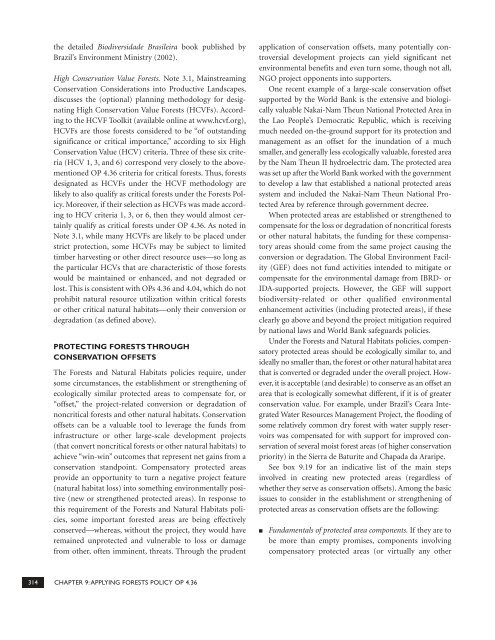Forests Sourcebook - HCV Resource Network
Forests Sourcebook - HCV Resource Network
Forests Sourcebook - HCV Resource Network
Create successful ePaper yourself
Turn your PDF publications into a flip-book with our unique Google optimized e-Paper software.
the detailed Biodiversidade Brasileira book published by<br />
Brazil’s Environment Ministry (2002).<br />
High Conservation Value <strong>Forests</strong>. Note 3.1, Mainstreaming<br />
Conservation Considerations into Productive Landscapes,<br />
discusses the (optional) planning methodology for designating<br />
High Conservation Value <strong>Forests</strong> (<strong>HCV</strong>Fs). According<br />
to the <strong>HCV</strong>F Toolkit (available online at www.hcvf.org),<br />
<strong>HCV</strong>Fs are those forests considered to be “of outstanding<br />
significance or critical importance,” according to six High<br />
Conservation Value (<strong>HCV</strong>) criteria. Three of these six criteria<br />
(<strong>HCV</strong> 1, 3, and 6) correspond very closely to the abovementioned<br />
OP 4.36 criteria for critical forests. Thus, forests<br />
designated as <strong>HCV</strong>Fs under the <strong>HCV</strong>F methodology are<br />
likely to also qualify as critical forests under the <strong>Forests</strong> Policy.<br />
Moreover, if their selection as <strong>HCV</strong>Fs was made according<br />
to <strong>HCV</strong> criteria 1, 3, or 6, then they would almost certainly<br />
qualify as critical forests under OP 4.36. As noted in<br />
Note 3.1, while many <strong>HCV</strong>Fs are likely to be placed under<br />
strict protection, some <strong>HCV</strong>Fs may be subject to limited<br />
timber harvesting or other direct resource uses—so long as<br />
the particular <strong>HCV</strong>s that are characteristic of those forests<br />
would be maintained or enhanced, and not degraded or<br />
lost. This is consistent with OPs 4.36 and 4.04, which do not<br />
prohibit natural resource utilization within critical forests<br />
or other critical natural habitats—only their conversion or<br />
degradation (as defined above).<br />
PROTECTING FORESTS THROUGH<br />
CONSERVATION OFFSETS<br />
The <strong>Forests</strong> and Natural Habitats policies require, under<br />
some circumstances, the establishment or strengthening of<br />
ecologically similar protected areas to compensate for, or<br />
“offset,” the project-related conversion or degradation of<br />
noncritical forests and other natural habitats. Conservation<br />
offsets can be a valuable tool to leverage the funds from<br />
infrastructure or other large-scale development projects<br />
(that convert noncritical forests or other natural habitats) to<br />
achieve “win-win” outcomes that represent net gains from a<br />
conservation standpoint. Compensatory protected areas<br />
provide an opportunity to turn a negative project feature<br />
(natural habitat loss) into something environmentally positive<br />
(new or strengthened protected areas). In response to<br />
this requirement of the <strong>Forests</strong> and Natural Habitats policies,<br />
some important forested areas are being effectively<br />
conserved—whereas, without the project, they would have<br />
remained unprotected and vulnerable to loss or damage<br />
from other, often imminent, threats. Through the prudent<br />
application of conservation offsets, many potentially controversial<br />
development projects can yield significant net<br />
environmental benefits and even turn some, though not all,<br />
NGO project opponents into supporters.<br />
One recent example of a large-scale conservation offset<br />
supported by the World Bank is the extensive and biologically<br />
valuable Nakai-Nam Theun National Protected Area in<br />
the Lao People’s Democratic Republic, which is receiving<br />
much needed on-the-ground support for its protection and<br />
management as an offset for the inundation of a much<br />
smaller, and generally less ecologically valuable, forested area<br />
by the Nam Theun II hydroelectric dam. The protected area<br />
was set up after the World Bank worked with the government<br />
to develop a law that established a national protected areas<br />
system and included the Nakai-Nam Theun National Protected<br />
Area by reference through government decree.<br />
When protected areas are established or strengthened to<br />
compensate for the loss or degradation of noncritical forests<br />
or other natural habitats, the funding for these compensatory<br />
areas should come from the same project causing the<br />
conversion or degradation. The Global Environment Facility<br />
(GEF) does not fund activities intended to mitigate or<br />
compensate for the environmental damage from IBRD- or<br />
IDA-supported projects. However, the GEF will support<br />
biodiversity-related or other qualified environmental<br />
enhancement activities (including protected areas), if these<br />
clearly go above and beyond the project mitigation required<br />
by national laws and World Bank safeguards policies.<br />
Under the <strong>Forests</strong> and Natural Habitats policies, compensatory<br />
protected areas should be ecologically similar to, and<br />
ideally no smaller than, the forest or other natural habitat area<br />
that is converted or degraded under the overall project. However,<br />
it is acceptable (and desirable) to conserve as an offset an<br />
area that is ecologically somewhat different, if it is of greater<br />
conservation value. For example, under Brazil’s Ceara Integrated<br />
Water <strong>Resource</strong>s Management Project, the flooding of<br />
some relatively common dry forest with water supply reservoirs<br />
was compensated for with support for improved conservation<br />
of several moist forest areas (of higher conservation<br />
priority) in the Sierra de Baturite and Chapada da Araripe.<br />
See box 9.19 for an indicative list of the main steps<br />
involved in creating new protected areas (regardless of<br />
whether they serve as conservation offsets). Among the basic<br />
issues to consider in the establishment or strengthening of<br />
protected areas as conservation offsets are the following:<br />
■<br />
Fundamentals of protected area components. If they are to<br />
be more than empty promises, components involving<br />
compensatory protected areas (or virtually any other<br />
314 CHAPTER 9:APPLYING FORESTS POLICY OP 4.36

















